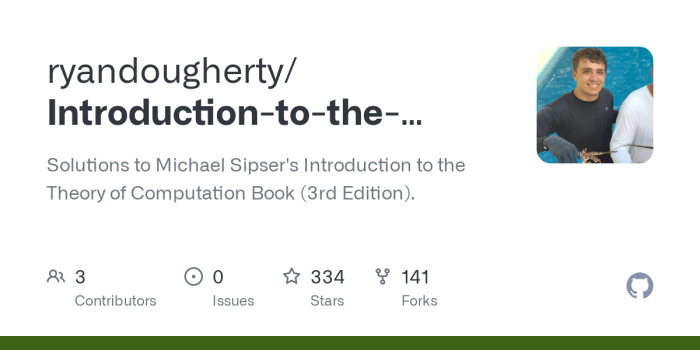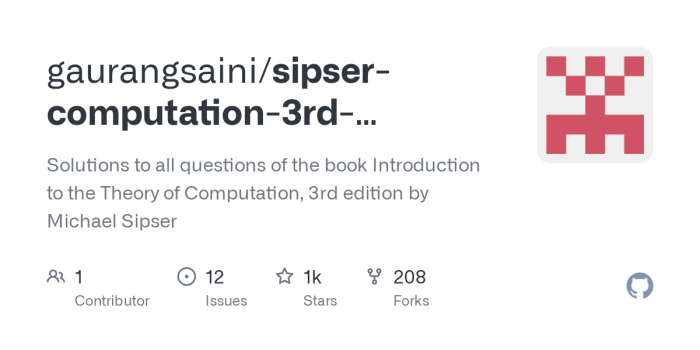Introduction to the theory of computation 3rd edition solutions – Introduction to the Theory of Computation, 3rd Edition Solutions opens the door to a captivating exploration of the fundamental principles underlying computing, providing a comprehensive and authoritative guide for students and practitioners alike.
This meticulously crafted resource delves into the intricacies of finite automata, regular languages, context-free grammars, pushdown automata, Turing machines, undecidability, and complexity theory, equipping readers with a deep understanding of the theoretical foundations of computation.
1. Introduction: Introduction To The Theory Of Computation 3rd Edition Solutions

The theory of computation is a branch of mathematics that studies the nature and limits of computation. It deals with the abstract concepts of computation, such as algorithms, languages, and machines. The theory of computation has applications in many areas of computer science, including the design of programming languages, compilers, and operating systems.
This textbook provides a comprehensive introduction to the theory of computation. It covers the following topics:
- Finite automata
- Regular languages
- Context-free grammars
- Pushdown automata
- Turing machines
- Undecidability
- Complexity theory
2. Finite Automata
A finite automaton is a mathematical model of a computing device that can be used to recognize regular languages. Finite automata are simple machines, but they can be used to solve a wide variety of problems, such as finding patterns in text, checking the validity of credit card numbers, and simulating the behavior of circuits.
There are two main types of finite automata: deterministic finite automata (DFAs) and nondeterministic finite automata (NFAs). DFAs are simpler than NFAs, but they are not as powerful. NFAs can recognize a wider range of languages than DFAs, but they are more difficult to design and analyze.
3. Regular Languages
A regular language is a language that can be recognized by a finite automaton. Regular languages are a very important class of languages, and they have many applications in computer science.
There are many different ways to define regular languages. One common way is to use regular expressions. A regular expression is a string of characters that describes a set of strings. For example, the regular expression [a-z]+matches any string that consists of one or more lowercase letters.
4. Context-Free Grammars
A context-free grammar (CFG) is a mathematical model of a language that can be used to generate sentences in that language. CFGs are more powerful than finite automata, and they can be used to generate a wider range of languages.
A CFG consists of a set of production rules. Each production rule consists of a left-hand side and a right-hand side. The left-hand side of a production rule is a single nonterminal symbol. The right-hand side of a production rule is a string of symbols, which may include both terminal and nonterminal symbols.
5. Pushdown Automata

A pushdown automaton (PDA) is a mathematical model of a computing device that can be used to recognize context-free languages. PDAs are more powerful than finite automata, and they can be used to recognize a wider range of languages.
A PDA consists of a finite set of states, a stack, and a transition function. The transition function specifies how the PDA moves from one state to another, and how the stack is modified, when the PDA reads a symbol from the input string.
6. Turing Machines

A Turing machine is a mathematical model of a computing device that can be used to compute any computable function. Turing machines are the most powerful type of computing device, and they can be used to solve any problem that can be solved by a computer.
A Turing machine consists of a tape, a head, and a finite set of states. The tape is divided into cells, each of which can store a single symbol. The head can read and write symbols on the tape, and it can move the tape left or right one cell at a time.
7. Undecidability
Undecidability is a property of a problem that means that there is no algorithm that can solve the problem for all possible inputs. Undecidable problems are very important in computer science, and they have applications in many areas, such as cryptography and artificial intelligence.
There are many different undecidable problems. One famous undecidable problem is the halting problem. The halting problem is the problem of determining whether a given program will halt on a given input.
8. Complexity Theory

Complexity theory is a branch of computer science that studies the computational complexity of problems. Computational complexity is a measure of how difficult a problem is to solve. Complexity theory is used to classify problems into different complexity classes, such as P, NP, and EXPTIME.
There are many different complexity classes. The most important complexity class is P. P is the class of problems that can be solved in polynomial time. Polynomial time means that the running time of the algorithm that solves the problem is bounded by a polynomial function of the size of the input.
FAQ Compilation
What is the significance of the theory of computation?
The theory of computation provides a rigorous mathematical framework for understanding the capabilities and limitations of computers, enabling us to analyze the efficiency and feasibility of algorithms and computational problems.
How does Introduction to the Theory of Computation, 3rd Edition Solutions differ from other resources?
This edition offers a comprehensive and up-to-date treatment of the subject, featuring revised content, additional examples, and improved pedagogical tools to enhance the learning experience.